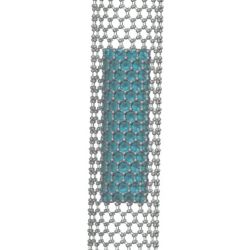
Molecular Dynamics Simulation of a Carbon Nanotube Gigahertz Oscillator
As part of his final project for the course Simulation Approaches to Bio- and Nanophysics (ASU PHY494/PHY598), C. Michael Gilbert performed classical molecular dynamics simulations of a smaller carbon nanotube in a larger one. Following the example of S. B. Legoas et al [Phys. Rev. Lett. 90 (2003), 055504] he showed that the system could stably oscillate in the 77–92 GHz range.
The movie Carbon Nanotube Oscillator.mov shows the outer nanotube in a silver stick representation that reveals the inner nanotube (cyan, space-filling (van der Waals
) representation). The oscillator is started by a kick to the inner tube. From then on, no further forces are imparted and the system evolves according to Newton's equations of motion. Multiple oscillations are shown, which become slightly damped over time as energy is transferred through frictional effects to the random thermal motion of the nanotube atoms.
Simulations were performed with the Gromacs molecular dynamics software package on the saguaro supercomputer at the ASU Advanced Computing Center (A2C2). The movie was prepared with VMD and rendered with the Tachyon ray tracer.
Metadata
Abstract
Following the paper Molecular Simulations of Carbon Nanotubes as Gigahertz Oscillators by S.B. Legoas et al., a CNT oscillator system was fashioned. The hope is to demonstrate the possibility of such oscillators for nanoscale machines. Using MD simulations in GROMACS with the AMBER99sb force field, two CNT oscillating systems, undergoing only Lennard Jones interactions in NVE, were constructed. The first system contains a coaxial CNT(9,0) within a CNT(18,0). The system is identical to that simulated by Legoas et al., except that the inner CNT(9,0) is not capped. Using both unrestrained and restrained positions for the CNT(18,0), with an imparted 1.2 nm/ps velocity on the CNT(9,0), oscillations in the gigahertz range were found between 77-92 GHz, twice that found by Legoas et al. A third system was constructed with an additional inner CNT(4,0), achieving stable oscillations for select velocities. Furthermore, damping is observed in the restrained systems, mimicking an undriven oscillator.
Acknowledgements
We are grateful to A2C2 for donating computing time to course PHY494/PHY598, which made this work possible.


